
Persian Journal of Acarology
Scope & Guideline
Exploring the intricate world of mites and ticks.
Introduction
Aims and Scopes
- Taxonomy and Systematics of Mites:
A core focus of the journal is the identification and classification of various mite families and genera. Researchers publish taxonomic studies that often include descriptions of new species and revisions of existing classifications. - Ecological and Environmental Interactions:
The journal publishes research on the ecological roles of mites, including their interactions with plants, other arthropods, and environmental factors. This encompasses studies on population dynamics, host specificity, and the impact of abiotic factors. - Pest Management and Biological Control:
A significant area of research involves the exploration of biological control agents, particularly predatory mites, and their effectiveness in managing agricultural pests. Studies often assess the efficacy of natural enemies and integrated pest management strategies. - Impact of Climate and Abiotic Factors:
The journal includes studies that evaluate how climate change and other abiotic factors influence mite populations and behaviors, highlighting their adaptability and responses to environmental changes. - Health and Veterinary Acarology:
Another important aspect is the study of ticks and their role as vectors of diseases, contributing to veterinary science and public health. This includes research on tick-borne pathogens and their ecological implications.
Trending and Emerging
- Molecular Techniques in Acarology:
There is an increasing trend in the application of molecular techniques for the identification and study of mites and ticks. This includes the use of DNA barcoding and genetic analyses to resolve taxonomic ambiguities and understand population genetics. - Impact of Climate Change on Mite Biology:
Research focusing on the effects of climate change on mite populations and their interactions with ecosystems has gained momentum. This theme is critical as it addresses the implications of global warming on agricultural practices and pest management. - Integrative Pest Management Strategies:
There is a growing emphasis on integrative pest management (IPM) that combines biological control, ecological insights, and sustainable practices to manage mite populations effectively, reflecting an overall shift towards sustainability in agriculture. - Health Implications of Mites and Ticks:
Studies exploring the health implications of mites and ticks, particularly their role as vectors for zoonotic diseases, have become more prominent, highlighting the intersection of acarology with public health. - Innovative Biological Control Methods:
Emerging research on innovative biological control methods, including the use of entomopathogenic fungi and plant extracts, showcases a trend towards sustainable and eco-friendly pest management solutions.
Declining or Waning
- Studies on Stored Product Mites:
Research focusing on mites associated with stored products has decreased, possibly due to an increased focus on agricultural pests and biological control agents in crop production. - Traditional Acaricides and Chemical Control:
There is a noticeable decline in studies solely focused on chemical control methods, including traditional acaricides, as the field shifts towards more integrated and environmentally friendly pest management practices. - General Faunistic Surveys without Specific Focus:
While faunistic surveys are still published, there is a trend towards more targeted studies that address specific ecological questions or management strategies, leading to a reduction in broad surveys without deeper ecological insights.
Similar Journals
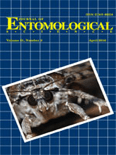
JOURNAL OF ENTOMOLOGICAL SCIENCE
Innovative Research for a Deeper Understanding of InsectsJOURNAL OF ENTOMOLOGICAL SCIENCE, published by the Georgia Entomological Society Inc, is a crucial resource in the field of insect science and ecology. With a rich history since its inception in 1993, the journal provides a platform for innovative research and comprehensive reviews addressing various aspects of entomology. Although not an open-access journal, it is highly regarded within its community, holding a Q3 ranking in Agronomy and Crop Science, Ecology, Evolution, Behavior and Systematics, and Insect Science as of 2023. Each issue promises to contribute valuable insights to professionals, researchers, and students alike, making it an essential publication for those looking to stay abreast of developments in entomological studies. The journal's editorial commitment ensures that it remains at the forefront of entomological research through rigorous peer reviews and a dedication to scholarly excellence.

REVISTA COLOMBIANA DE ENTOMOLOGIA
Connecting Biodiversity and Agriculture through Insect StudiesREVISTA COLOMBIANA DE ENTOMOLOGIA, published by the SOC COLOMBIANA ENTOMOLOGIA-SOCOLEN, serves as a vital platform for disseminating research in the field of insect science. With an ISSN of 0120-0488, the journal has established itself as a key resource for entomologists, agricultural scientists, and biodiversity researchers, focusing on the ecology, taxonomy, and behavior of insects within the Colombian context and beyond. Despite its Q4 ranking in 2023, REVISTA COLOMBIANA DE ENTOMOLOGIA strives to enhance its impact within the academic community, offering a space for innovative studies and reviews that aim to advance the understanding of insect-related phenomena. As a publication addressing critical concerns in agricultural and biological sciences, it invites contributions that explore new methodologies and findings relevant to the insect world. Although it does not currently offer Open Access options, the journal's growth from 2004 to 2024 reflects its commitment to evolving with the needs of its readership and contributors, making it an essential reference point for students and professionals alike interested in entomological research.

EXPERIMENTAL AND APPLIED ACAROLOGY
Innovating Acarology: Where Research Meets Real-World ImpactEXPERIMENTAL AND APPLIED ACAROLOGY is a leading international journal that serves as a premier platform for the dissemination of cutting-edge research in the fields of Ecology, Insect Science, and Medical applications related to acarology. Published by Springer, this esteemed journal has been pivotal in advancing our understanding of mite-related science since its inception in 1985, and it anticipates continued publication until 2024. With an impressive ranking in the Q2 quartile across multiple categories, including Ecology (Rank #154/461) and Insect Science (Rank #42/181), it firmly establishes itself as a significant contributor to the scientific community. Although not an Open Access journal, its rigorous peer-review process ensures high-quality publication standards, appealing to researchers, professionals, and students alike. Aiming to bridge gaps between experimental research and practical applications, EXPERIMENTAL AND APPLIED ACAROLOGY plays a crucial role in enhancing knowledge and discoveries related to acarology, highlighting its vital importance in ecology and health sciences.
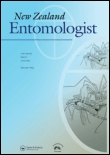
NEW ZEALAND ENTOMOLOGIST
Advancing Entomological Knowledge, One Article at a TimeNEW ZEALAND ENTOMOLOGIST, published by Taylor & Francis Ltd, is a distinguished journal in the field of Insect Science, featuring a rich history dating back to its initial publication in 1952. As a platform for sharing innovative research and critical insights, this journal serves as a vital resource for entomologists and scientists interested in the diverse aspects of insect biology, ecology, and behavior. Although it currently holds a Q4 category in its discipline with Scopus ranking it at the 163rd out of 181 journals, the NEW ZEALAND ENTOMOLOGIST continues to uphold high-quality standards of peer-reviewed articles that contribute significantly to the understanding of insects, particularly within the unique ecosystems of New Zealand. Researchers and professionals are encouraged to submit their findings to enhance the journal's growing repository of knowledge, while students will find a wealth of information to aid their studies and foster their interest in entomological research.
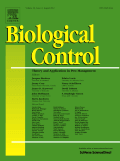
BIOLOGICAL CONTROL
Leading the Charge in Ecological Pest Management SolutionsBIOLOGICAL CONTROL, published by Academic Press Inc Elsevier Science, is a prestigious journal focusing on the advancement of knowledge in the field of biological pest control and integrated pest management. With a high-impact factor reflecting its significant contributions to agronomy and insect science, it has secured elite positions in both Q1 categories as of 2023. The journal ranks within the top 6% and 12% of its fields on Scopus, making it an essential resource for researchers and professionals dedicated to sustainable agricultural practices and ecological balance. With its comprehensive exploration of theoretical and applied studies from 1991 to 2024, BIOLOGICAL CONTROL serves as a critical platform for disseminating innovative research and promoting dialogue among scholars, students, and practitioners. Although the journal follows a subscription-based access model, it consistently attracts contributions that shape the future of pest management strategies.

JOURNAL OF PEST SCIENCE
Fostering collaboration in the realm of pest science.JOURNAL OF PEST SCIENCE, published by SPRINGER HEIDELBERG, is a premier academic journal dedicated to the multidisciplinary study of pest management, contributing significantly to the fields of Agronomy, Ecology, and Insect Science. With a history that spans back to 1925, this journal has established itself as a critical platform for disseminating innovative research, evidenced by its impressive Q1 rankings in multiple categories, including Ecology and Plant Science, as of 2023. The journal particularly excels in its contribution to Agricultural and Biological Sciences, holding a remarkable 98th percentile rank in Insect Science. By fostering open access, the JOURNAL OF PEST SCIENCE ensures broader dissemination and engagement with scientific advancements pertinent to pest control and management practices. Its commitment to publishing high-quality, peer-reviewed articles makes it an essential resource for researchers, professionals, and students looking to stay at the forefront of pest science and its application to sustainable agriculture and ecology.
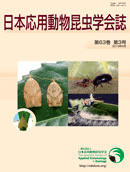
JAPANESE JOURNAL OF APPLIED ENTOMOLOGY AND ZOOLOGY
Innovating for Sustainable Pest ManagementJapanese Journal of Applied Entomology and Zoology is a premier publication in the field of Insect Science, offering a platform for researchers and practitioners to share their findings on applied entomology and zoology. Established in 1957 and published by the Japan Society of Applied Entomology and Zoology, this journal aims to foster the understanding of insect-related studies that impact agriculture, ecology, and biodiversity. With an ISSN of 0021-4914 and E-ISSN of 1347-6068, it serves as a crucial resource for both academics and industry professionals. While the journal currently resides in the Q4 category of the Scopus ranking for Insect Science with a percentile of 11th, it plays a significant role in providing valuable insights into insect behavior, systematics, and their ecological roles. Readers can benefit from its published research to drive innovations and solutions in pest management and conservation practices. As the journal continues to evolve, it reinforces its commitment to disseminating critical research that supports sustainable practices in entomology and zoology through its convergence extending to the year 2024.
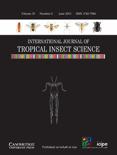
INTERNATIONAL JOURNAL OF TROPICAL INSECT SCIENCE
Exploring the Ecological Impact of Insect DiversityINTERNATIONAL JOURNAL OF TROPICAL INSECT SCIENCE, published by Springer International Publishing AG, is a leading interdisciplinary journal dedicated to advancing knowledge in the fields of insect science and ecology. With its ISSN 1742-7584 and E-ISSN 1742-7592, this journal provides a platform for researchers to publish high-quality, peer-reviewed articles that explore various aspects of tropical insect biology, behavior, and their ecological impacts. As evidenced by its Q3 ranking in both Ecology, Evolution, Behavior and Systematics and Insect Science, it plays a vital role in fostering scientific dialogue and innovation within these disciplines. Researchers affiliated with the journal benefit from its visibility and growing impact, as demonstrated by its Scopus ranks, with a percentile standing of 61st in Insect Science. Although the journal is not open access, it still reaches a wide academic audience, making significant contributions to our understanding of tropical ecosystems. Situated in Switzerland, this journal is crucial for students, professionals, and researchers invested in the intersection of entomology and ecological science.
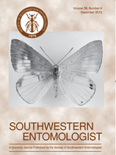
SOUTHWESTERN ENTOMOLOGIST
Advancing Knowledge in Entomology and EcologySOUTHWESTERN ENTOMOLOGIST is a pivotal academic journal dedicated to advancing the fields of Agronomy, Ecology, and Insect Science. Published by the SOUTHWESTERN ENTOMOLOGICAL SOC in the United States, this journal plays a crucial role in disseminating vital research findings that address pressing ecological and agricultural challenges. With its ISSN 0147-1724 and E-ISSN 2162-2647, the journal has been publishing comprehensive studies since 1993 and continues to contribute significantly to the knowledge base up to 2024. As a Q4 ranked journal in both Agronomy and Crop Science and Ecology, as well as Insect Science, it provides an inclusive platform for researchers and students to share their insights and foster collaborations. Although it currently does not offer open access options, the content is accessible to academic institutions and professionals, ensuring that significant findings reach a broad audience. Given its niche focus, SOUTHWESTERN ENTOMOLOGIST not only appeals to researchers and students but also to professionals looking to stay updated on the latest trends and developments in entomology and its related fields.

ACAROLOGIA
Bridging Fundamental and Applied Insect StudiesACAROLOGIA is an esteemed journal published by ACAROLOGIA-UNIVERSITE PAUL VALERY, specializing in the field of Insect Science. With an ISSN of 0044-586X and an e-ISSN of 2107-7207, this journal has been a pivotal resource for researchers and professionals since its inception in 1965. Located in Montpellier, France, it encompasses a broad scope of insect-related studies, contributing valuable insights into fundamental and applied entomology. The journal holds a prestigious position in the academic community, classified in the 2023 Q2 quartile of insect science, demonstrating its influence and relevance in the field. Furthermore, it ranks #86 out of 181 in Scopus’s Agricultural and Biological Sciences category, solidifying its standing among peer publications. Although it does not operate under an open access model, ACAROLOGIA remains a vital platform for disseminating innovative research from 1965 to the present, aspiring to foster a deeper understanding of insect biology and ecology. This journal serves not only as a repository of significant scientific findings but also as a catalyst for future studies and advancements in Insect Science.